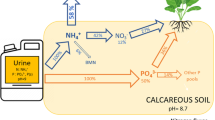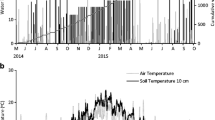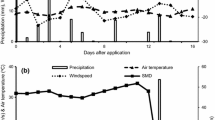Abstract
Important amounts of plant nutrients excreted by humans are found in human urine. This provides the motivation for separating urine and recycling it, as fertiliser, back to agricultural land for food or fodder production. There are some housing estates in Sweden, both blocks of flats and separate houses, in which urine-separating toilets have been installed. The urine is stored in covered basins and spread on agricultural land. The objective of the present study was to evaluate the influence of application rate, application techniques and time on NH3 emissions after application of source-separated human urine. Human urine was spread at different application rates (10, 20 and 60 Mg ha–1) before sowing (year 1 to 3) and when the barley crop was 20-30 cm high (year 2). Urine was spread with a plot spreader using two band-application techniques (with bands 0.25 m apart): trailing hoses and trailing shoes. In spring, band-spread urine with trailing hoses was incorporated with a harrow four hours after application. The four (year 1 and 3) or six (year 2) treatments were organised into a randomised block design with three replicates. An equilibrium concentration method was used for measuring ammonia emissions directly after application. After spring application with trailing hoses and harrowing after four hours, the nitrogen [N] loss as ammonia [NH3], average over 3 years, was 5% of the applied N, irrespective of the application rate. The largest loss (10% of the applied N) was measured after application of 60 t of urine per hectare in spring. Hardly any NH3 loss occurred after incorporation with a harrow, with the exception of the highest application rate. Loss of NH3 was very low, close to 1% of the applied N, when the urine was incorporated directly into the soil in spring by band application with trailing shoes. Virtually no emissions were detected when the urine was applied to the growing crop, neither by trailing hoses nor by trailing shoes. This study shows that it is possible to apply human urine on bare soil or in growing barley crop with very low losses of N as NH3. Together with careful handling and the use of covered storage, nutrients in human urine could be recycled from households to agricultural land with low NH3 emissions.
Similar content being viewed by others
References
APHA (American Public Health Association) 1985. Standard Methods, 16th edition 1985, St. Meth. 417A+d. APHA, Washington, DC.
FAO (Food and Agriculture Organisation of the United Nations) 1990. Guidelines for Soil Profile Description (3rd ed., revised). FAO, Rome, Italy, pp. 1–70.
Höglund C., Stenström T.A., Jönsson H. and Sundin A. 1998. Evaluation of faecal contamination and microbial die-off in urine separating sewage systems. Water Sci. Technol. 38(6): 17–25.
Höglund C. 2001. Evaluation of microbial health risks associated with the reuse of source-separated human urine. Ph.D. Thesis, Royal Institute of Technology (KTH) and Swedish Institute for Infectious Disease Control (SMI), Stockholm, Sweden.
Höglund C., Stenström T.A. and Ashbolt N. 2002. Microbial risk assessment of source-separated urine used in agriculture. Waste Manage. Res. 20: 150–161.
Iversen K. 1947. Stalgödningens anvendelse. Svenska vall-och mosskulturföreningens kvartalsskrift 2. [The use of manure. The Swedish Society of Grassland Federations, No. 2]. Uppsala, Sweden.
Jönsson H., Stenström T.A., Svensson J. and Sundin A. 1997. Source separated urine-nutrient and heavy metal content, water saving and faecal contamination. Water Sci. Technol. 35: 145–152.
Jönsson H., VinnerÄs B., Höglund C. and Stenström T.A. 1999. Source separation of urine. Wasser & Boden 51: 21–25.
Jönsson H., VinnerÄs B., Höglund C., Stenström T.A., Dalhammar G. and Kirchmann H. 2000. Källsorterad humanurin i kretslopp. [Source-separated urine in recycling.] VA-Forsk report 1. VAV, Stockholm, Sweden.
Karlsson S. 1996. Measures to reduce ammonia losses from storage containers for liquid manure. Poster presented at AgEng International Conference on Agricultural Engineering, Madrid, 23-26 September 1996. Report No 96E-013.
Kirchmann H. and Pettersson S. 1995. Human urine-chemical composition and fertilizer use efficiency. Fert. Res. 40: 149–154.
Misselbrook T.H., Nicholson F.A. and Chambers B.J. 2002. Predicting ammonia losses following the application of livestock manure to land. Paper presented at the 10th International Conference RAMIRAN, May 14-18, 2002 in Štrbské Pleso, High Tatras, Slovak Republic.
Richert Stintzing A., Rodhe L., Äkerhielm H. and Steineck S. 2002. Human urine as a fertiliser-plant nutrients, application technique and environmental effects. Abstract from the 10th International Conference RAMIRAN, May 14-18, 2002 in Štrbské Pleso, High Tatras, Slovak Republic.
Rodhe L. and Johansson S. 1996. Urin-spridningsteknik, ammoniakavgÄng och växtnäringsutnyttjande. [Ammonia emission and nutrient utilisation from urine using different techniques for application]. JTI report no.217. Jordbrukstekniska Institutet, Uppsala, Sweden.
Rodhe L., Salomon E. and Johansson S. 1997. Spreading of cattle urine to leys: techniques, ammonia emissions and crop yields. In: Jarvis S.C. and Pain B.F. (eds), Gaseous Nitrogen Emissions from Grasslands. CAB International, Wallingford, UK, pp. 109–114.
SAS Institute Inc. 1994. SAS/STAT(r) User's Guide, Version 6, Fourth Edn. SAS, Cary, NC.
SCB 2000. Gödselmedel i jordbruket 1998/99. Tillförsel till Äkergrödor samt hantering och lagring av stallgödsel. [Fertiliser in agriculture 1998/99. Application to crops, handling and storing of manure]. Statistiska meddelanden MI 30 SM 0002. Statistics Sweden, Stockholm, Sweden.
SIS (Swedish Standards Institute) 1976. Swedish Standard: SIS 028134. SIS, Stockholm, Sweden.
SIS (Swedish Standards Institute) 2000. Swedish standards: SS-EN 12176-1, SS 028113-1, SS 028101-1. SIS, Stockholm, Sweden.
Sögaard H.T., Sommer S.G., Hutchings N.J., Huijsmans J., Bussink W. and Nickelson F. 2001. Ammonia volatilisation from manure applied to fields-data collection for an EU database and its statistical analysis. Proceedings, NJF-seminar no. 320 "Sustainable handling and utilisation of livestock manure from animals to plants", Denmark 16-19 January 2001. DIAS report No. 21. Animal Husbandry. Danish Institute of Agricultural Sciences, Denmark.
Svensson L. 1994. A new dynamic chamber technique for measuring ammonia emissions from landspread manure and fertilisers. Acta Agriculturae Scandinavica, Section B. Soil Plant Sci. 44: 35–46.
VinnerÄs B. 2002. Possibilities for sustainable nutrient recycling by faecal separation combined with urine diversion. Ph.D. Thesis, Swedish University of Agricultural Sciences, Uppsala, Sweden. ISSN 1401-6249, IBN 91-576-6167-7.
Rights and permissions
About this article
Cite this article
Rodhe, L., Richert Stintzing, A. & Steineck, S. Ammonia emissions after application of human urine to a clay soil for barley growth. Nutrient Cycling in Agroecosystems 68, 191–198 (2004). https://doi.org/10.1023/B:FRES.0000019046.10885.ee
Issue Date:
DOI: https://doi.org/10.1023/B:FRES.0000019046.10885.ee




